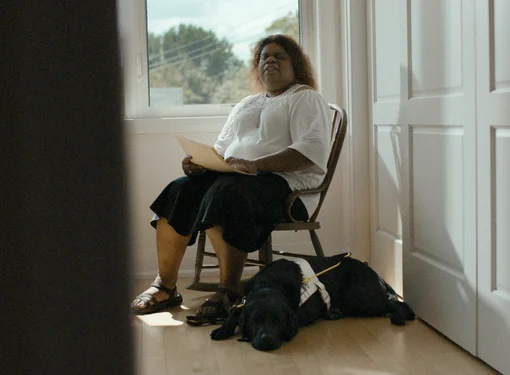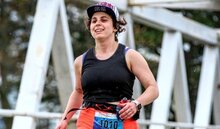My Experience Traveling with Low Vision
When my brother asked me to travel with him to Poland on a group trip to visit historical Nazi concentration camps, I momentarily forgot that I have low vision and replied, “I’M IN!”
The trip was an exciting opportunity because I have been writing a memoir about intergenerational Holocaust trauma. My grandparents were all survivors of the Holocaust and I like to take advantage of any opportunity I have to learn more so that I can become a better teacher to future generations. It never occurred to me that my low vision might add discomfort to an already intense experience.
I live with Retinitis Pigmentosa (RP), an inherited retinal disease which causes progressive vision loss. Currently, I have limited peripheral vision and most environments appear to be either too bright or too dark. Navigating new spaces usually requires me to use a white cane or my hands for safety.
As an introvert, I rarely ask others for guidance and I often stick to familiar spaces in order to avoid the necessity of another person’s care. Guidance — which I did not anticipate needing on my trip — isn’t always comfortable. Traveling in a large group pushed me to communicate my discomforts so that other people could properly help.

The Trip
Upon receiving my ticket, I remembered how I failed to self-advocate the last time I traveled. At the time, I did not have a cane and when I asked the flight attendant for help she said, “it doesn’t say you’re blind on your ticket.”
Remembering that lesson, I emailed the travel agent to ask her to notify the airline. The agent informed me that she could arrange for wheelchair assistance. I explained that I don’t need a wheelchair.
“I just can't see what's around me and would like someone to guide me,” I told her, imagining that someone could just offer me their arm and guide me to my gate.
Michelle explained, “Unfortunately, they would not have a person who can guide through the airport without wheelchair assistance.”
The flight to Poland was thankfully less stressful. While I didn’t need the wheelchair, it helped that my boarding pass said “BLND.” At security, I was offered the Special Assistance Line which was less chaotic. I unpacked my iPad and I left everything in two bins, including my cane.
“Are you ok to walk through without it?” the officer asked.
I nodded. She pointed to the metal detector. I followed strangers until I found it. I walked through and found my bag — a bright red easy-to-spot-backpack – and waited in a chair for my family.
Warsaw
My first shock in Warsaw came during a museum visit. The exhibit was dark and the harsh spotlights overwhelmed the space. I couldn’t see or read anything. I was lost. My mother guided me. Eventually we stepped into a narrow hallway. As museum-goers brushed past me, I panicked and promptly exited.
Next, a walking tour through Poland’s traffic and crowds confused and overwhelmed my senses. Across busy intersections, through crowded markets, our guide described the sites but I could not find them.
The following day, I tried to go for a walk by myself but the street signs and pedestrian signals were too confusing. As I walked with my cane, a woman grabbed my arm and dragged me across the intersection, chatting in Polish and smiling.
“I’m okay, I’m okay,” I repeated.
She deposited me on the sidewalk and left. Hunched on a bench, I regretted leaving home.
The Group Tour
Most of the group tour was inaccessible. Many of the museums and sites had uneven grounds and unlit exhibits or were lit with a single light bulb and a wall of bright windows. Steps were unmarked and ramps were rare. The awkward environments, combined with a loud crowd of 180 people, all of whom were using flash photography, meant that the trip was becoming a nightmare.
Small things became irritations. Stopping for the washroom, getting on and off the bus, keeping track of my luggage, elevators, hotel hallways, everything was a slow process for me and, with the huge number of people who were on the tour watching, it was humiliating.
This trip had long days and early mornings with no opportunity for recovery. As my nervous system overloaded, I learned to lean on my brother. My parents were on a separate bus but he sat beside me every day and became a great guide. He even accepted advice from an ophthalmologist who happened to be on our bus.
“Never grab her. Let her take your arm,” our new friend demonstrated and my brother paid attention.
As soon as I went anywhere without my brother, someone would grab my arm and drag me wherever they believed I should go. At first, I was too shy to resist. But, at the end of the tour, while visiting Birkenau, someone grabbed my arm without announcing themselves and pulled me into dark barracks.
“You don't have to grab me!” I yelled.
“Oh, sorry,” I turned to see one of the women from our group. “I just noticed that you weren’t being helped.”
I told my brother about the incident.
“I’m glad we came so that I can see what you go through,” he said.
He was right. Growing closer with my brother was the best part of the trip. While the trip was physically uncomfortable, fostering connections in this way ultimately enriched my travel experience, as well as personal growth. It also reinforced the urgent need for a world that everyone can navigate so that they too can embrace the wonders of new experiences with unrestricted ease and independence.







